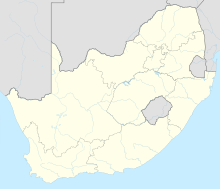| Battle of Paardeberg | |||||||
|---|---|---|---|---|---|---|---|
| Part of Second Boer War | |||||||
 Sketch depicting British and Boer positions at Paardeberg Drift | |||||||
| |||||||
| Belligerents | |||||||
|
|
| ||||||
| Commanders and leaders | |||||||
|
|
| ||||||
| Strength | |||||||
| 15,000 men | 7,000 men | ||||||
| Casualties and losses | |||||||
|
348 killed 942 wounded[1] |
350 killed and wounded 4,019 captured[1] | ||||||
Battle of Paardeberg | |||||||
The Battle of Paardeberg or Perdeberg ("Horse Mountain", 18–27 February 1900) was a major battle during the Second Anglo-Boer War. It was fought near Paardeberg Drift on the banks of the Modder River in the Orange Free State near Kimberley (now in Letsemeng Local Municipality, Free State).
Lord Methuen advanced up the railway line in November 1899 with the objective of relieving the Siege of Kimberley (and the town of Mafeking, also under siege). Battles were fought on this front at Graspan, Belmont, Modder River before the advance was halted for two months after the British defeat at the Battle of Magersfontein. In February 1900, Field Marshal Lord Roberts assumed personal command of a significantly reinforced British offensive.
The army of Boer General Piet Cronjé was retreating from its entrenched position at Magersfontein towards Bloemfontein after its lines of communication were cut by Major General John French, whose cavalry had recently outflanked the Boer position to relieve Kimberley. Cronjé's slow-moving column was intercepted by French at Paardeberg, where the Boer general eventually surrendered after a prolonged siege, having fought off an attempted direct assault by Lieutenant General Herbert Kitchener.
- ^ a b Hickman 2009.
